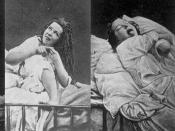Whilst Anna O's, or rather Bertha Pappenheim's place in the history of hysteria, and subsequently psychoanalysis, is undoubtedly crucial, we must, in order to understand her own condition and that of her case biographers, place this infamous patient in her rightful historical context.
Hysteria's long history has always been acknowledged, indeed medical writers throughout its duration, and particularly in the last two centuries, have referred tenderly to its classical ancestry, to its glorious "founding father", Hippocrates. For such medical writers the existence of an ancient tradition, of hysteria diagnosis and treatment, has harboured a righteous belief in the sanctity of the category, in medical efforts to control the disorder and in the universality of hysteria as a disease category. However, as recent studies have revealed, in particular, the work of Helen King, the Hippocratic texts to which physicians have charted their lineage- The Nature of Women and Diseases of Women, may well lack the medical and linguistic cement that was, in the history writing of hysteria, always assumed to be there.
King, a British classicist, embarked upon a full- scale linguistic analysis of the above text and found, contrary to popular belief, that at no point in the text was the term hysteria used to describe a disease of women, instead she found a frequent referral to the "hystera", meaning the uterus and also to the category- "hysterikos" pertaining to a number of symptoms, described as being "of the womb" or "from the womb". The error of this assumption King traces back to Ilza Veith's momentous historical study of Hysteria in 1965, an error essentially of translation- for Veith had read the nineteenth century version of the Hippocratic text, translated by a physician and classicist Emile Littre, a man who despite his overall accuracy had, perhaps for ease and...


